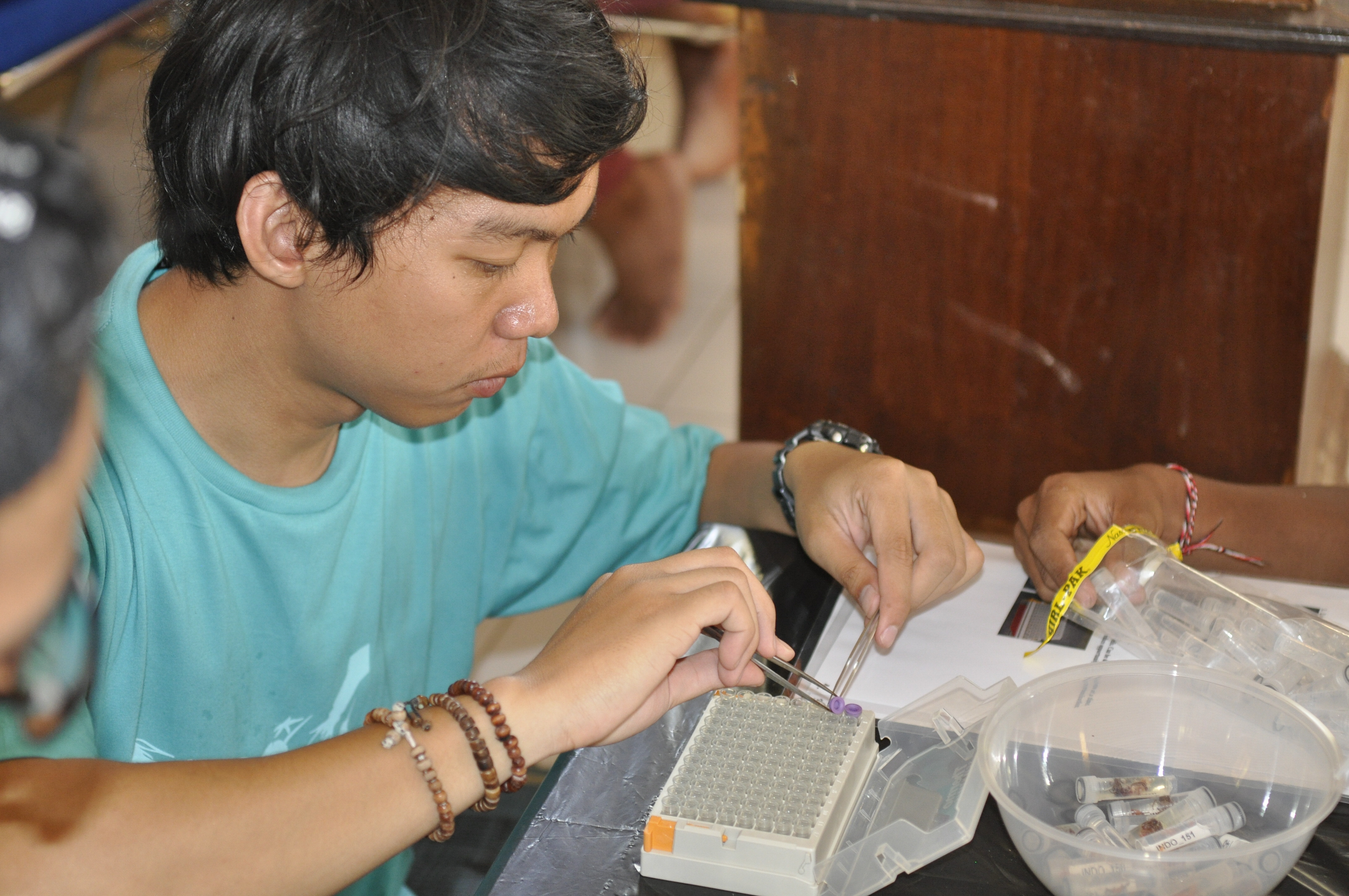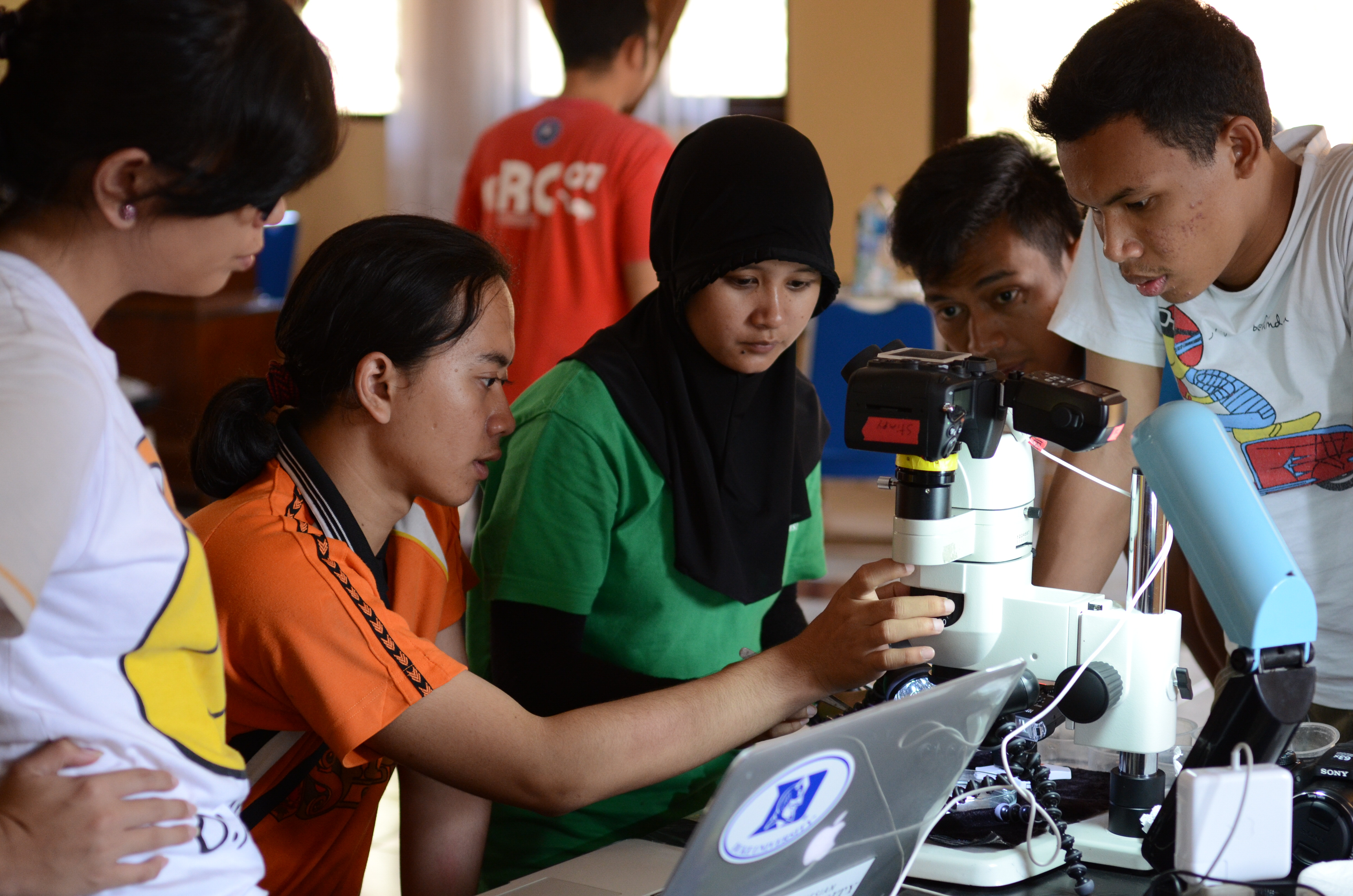|
Cycle 4 (2015 Deadline)
One Fits All: developing decapods biodiversity research for education, conservation and research benefits
PI: Ambariyanto (ambariyanto.undip@gmail.com, ibrcbali@gmail.com), Indonesian Biodiversity Research Center and Diponegoro University
U.S. Partner: Christopher Meyer, Smithsonian National Museum of Natural History
Project Dates: January 2016 - June 2021
Project website: https://dipbio.undip.ac.id
Project Overview
 |  | | Photos courtesy of Andrianus Sembiring |
Biodiversity is defined as the variety of organisms within a given area. The Convention on Biological Diversity indicates that the richer the diversity of life, the greater the opportunity for economic growth. However, despite having the highest marine biodiversity in the world, Indonesia frequently faces significant economic challenges and poor development due to unsustainable exploitation of their natural resources. Efforts to quantify biodiversity have traditionally relied on easily observed parameters like coral cover and fish biomass, while smaller invertebrates that significantly contribute to reef diversity are often ignored due to difficulties in identification, potentially resulting in inaccurate assessment of biodiversity and reef health. Although Indonesia is home to seas featuring more than half of all known marine species, not all taxa of these species have been assessed and quantified, and local expertise to support biodiversity research is small in relation to Indonesia’s size and biodiversity. This project focuses on quantifying the biodiversity of decapods (an order of crustaceans that includes crayfish, crabs, lobsters, prawns, and shrimp) across the Indonesia while also nurturing international collaboration and improving local taxonomic expertise. The research team will implement an integrated research and education program using autonomous reef monitoring structure (ARMS) and dead coral heads (DCH) as artificial and natural collection platforms for reef-associated decapods. Decapod diversity will then be assessed using both traditional taxonomy and cutting-edge genetic approaches. The results of this project will provide the first insights into the magnitude of marine biodiversity in one of the most diverse groups of marine metazoans in Indonesia, while also assessing how this diversity is distributed throughout the archipelago. Results will help inform local researchers and managers regarding health of reef ecosystems across Indonesia, facilitating the development of conservation strategies based on current biodiversity assessments.
The data collected will be helpful in designing management strategies to preserve biodiversity hotspots within Indonesia and in focusing conservation efforts on particularly threatened areas. Trainings and workshops organized through this project will increase local capacity to develop high quality biodiversity research and nurture the growth of local taxonomists. In addition, smartphone applications (www.dnabarcodingassistant.org) and online database produced through this project will, for the first time, make biodiversity research accessible to people beyond the scientific community, which is critical for mobilizing grassroots support for marine conservation. Through joint research and educational programs with the Smithsonian Institution, the team will train dozens of Indonesian students and researchers through experiential learning in research-intensive courses. By using research as a platform for education, the project will simultaneously improve understanding of Indonesian marine biodiversity and develop the next generation of biodiversity scientists.
Final Summary of Project Activities
During the course of this project, which ran for five and a half years, Prof. Ambariyanto and his team trained almost 300 students, involved around 20 institutions, and collected more than 10,000 decapod samples. Ten graduate and undergraduate students wrote their theses based on data from the project and graduated successfully. As of August 2021, the project team had published three journal articles, three proceedings abstracts, and one book chapter based on their work on the project, with at least two more research papers in preparation. By working closely with universities across Indonesia, particularly in areas where the samples were collected, the team also developed capacity building programs and incorporated their dead coral head analysis methodology into the curriculum at the partner universities. Besides universities, they also collaborated with three local NGOs (Yayasan ReefCheck Indonesia, Yayasan Misool Basetfin, and Yayasan TAKA) to develop educational and awareness programs on environmental and coastal education in both central Java and the Savu seas, Eastern Indonesia.
The decapod samples collected under the project have been identified and catalogued in a database, with the original samples being stored at Universitas Diponegoro, where they will be made accessible and become assets for future research. The data and biodiversity information associated with it have also been shared and communicated with local stakeholders to ensure the information can be used for conservation and management use. In addition, most of the data generated through this project are accessible through the Smithsonian’s Genomic Observatories MetaDatabase (GEOME) (https://geome-db.org/workbench/project-overview?projectId=78) and can be downloaded free of charge.
Although at the time the project ended in June 2021, there had not yet been any policy impacts from the project, the PI reports that the data have informed stakeholders on the importance of incorporating diversity parameters into biodiversity management and conservation practices. Among others, TAKA (an NGO in central Java) has used the data for educational activities around coastal areas in their region. Given the success of these activities, more frequent educational events are expected to be held in the area.
Meanwhile, Prof. Ambariyanto reports that he has received approximately $104,000 in research grants (one international and six Indonesian) to continue and expand on the work begun under the PEER project. Universitas Diponegoro also has a small grant scheme to facilitate research activities for students and lecturers. The PI will encourage all his lab members to apply for funding to do further work on the existing species database and expand sampling and new research activities. The institutional linkages built and cohort of students and junior researchers trained during the years of the PEER project also represent a wonderful resource that has strengthened the marine biodiversity research community in Indonesia. Prof. Ambariyanto points out that PEER has provided him and his team with the flexibility to do research that can combine data generation and exploration with capacity building. PEER support has also made it possible to add valuable and previously unavailable biodiversity data from Indonesia to a globally accessible database while simultaneously nurturing the research capacity and interests of the rising generation of marine scientists across Indonesia. The PI also notes that PEER has provided an immense opportunity to collaborate with a leading U.S. researcher, broadening his team’s research network and facilitating intensive knowledge exchange between the two countries. He and his group expect to continue the collaboration and produce further joint publications based on the large amount of data they have collected.
Publications
Ambariyanto, A., Cahyani, N.K.D., Anggoro, A.W., Kurniasih, E.M., Sembiring, A., Pertiwi, N.P.D., Malik, M.D.A. 2021.Teknik Estimasi Keragaman Hayati Terumbu Karang Dengan Metode “Dead Coral Head”. Media Nusa Creative, Malang, Indonesia. [book chapter]
Kurniasih, E.M., Sembiring, A., Pertiwi, N.P.D., Anggoro, A.W., Cahyani, N.K.D., Dailami, M., Ambariyanto., Wijayanti, D.P., Meyer, C.P. 2020. Cryptic Species from Biodiversity Hotspot: Estimation of Decapoda on Dead Coral Head Pocillopora in Raja Ampat Papua. Indonesian Journal of Marine Sciences Vol 25(1):1-6 http://dx.doi.org/10.14710/ik.ijms.25.1.1-6
Tirtana, E.A., Nugraha, W.A. 2018. Struktur Komunitas Anomura (Dekapoda) Pada Karang Mati Pocillopora Spp. Di Pulau Cemara Besar Kepulauan karimun jawa Kabupaten Jepara. Jurnal Ilmiah REKAYASA Vol 11 (1):37-45 https://journal.trunojoyo.ac.id/rekayasa/article/view/4123
Pertiwi. P.D., Malik.M.D.A., Kholilah.N., Kurniasih. E.M., Sembiring. A., Anggoro. A. W., Ambariyanto., Meyer. C. 2018. Community Structure of Decapod Inhabit Dead Coral Pocillopora sp. in Pemuteran, Bali. IOP Conf. Series: Earth and Environmental Science 116; https://doi.org/10.1088/1755-1315/116/1/012055.
Tawakkal, M., Devira, C.N., Ulfah, M., Sembiring, a., Kurniasih, E.M., Ambariyanto., Meyer, C. 2017. Composition of Brachyura Cryptic Organism (Crustacea) on The Pocillopora Dead Coral in Sabang Island. Jurnnal Ilmiah Mahasiswa Kelautan dan perikanan Unsyiah. Vol: 2(4):547-555. http://www.jim.unsyiah.ac.id/fkp/article/viewFile/7778/3372
Malik.M.D.A., Kholilah.N., Kurniasih. E.M., Sembiring. A., Pertiwi. P.D., Ambariyanto., Munasik., Meyer. C. 2018. Biodiversity of Cryptofauna (Decapods) and Their Correlation with Dead Coral Pocillopora sp. Volume at Bunaken Island, North Sulawesi . IOP Conf. Series: Earth and Environmental Science 116; http://dx.doi.org/10.1088/1755-1315/116/1/012053.
Kholilah.N., Malik.M.D.A., Kurniasih. E.M., Sembiring. Ambariyanto., Meyer. C. 2018. Conditions of Decapods Infraorders in Dead Coral Pocillopora sp. at Pemuteran, Bali: Study Case 2011 and 2016 . IOP Conf. Series: Earth and Environmental Science 116; doi:10.1088/1755-1315/116/1/012070. https://iopscience.iop.org/article/10.1088/1755-1315/116/1/012070
|





